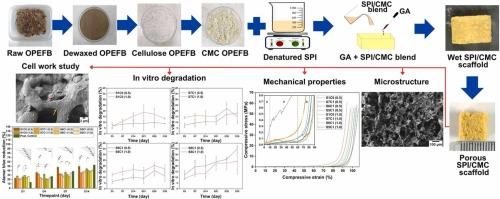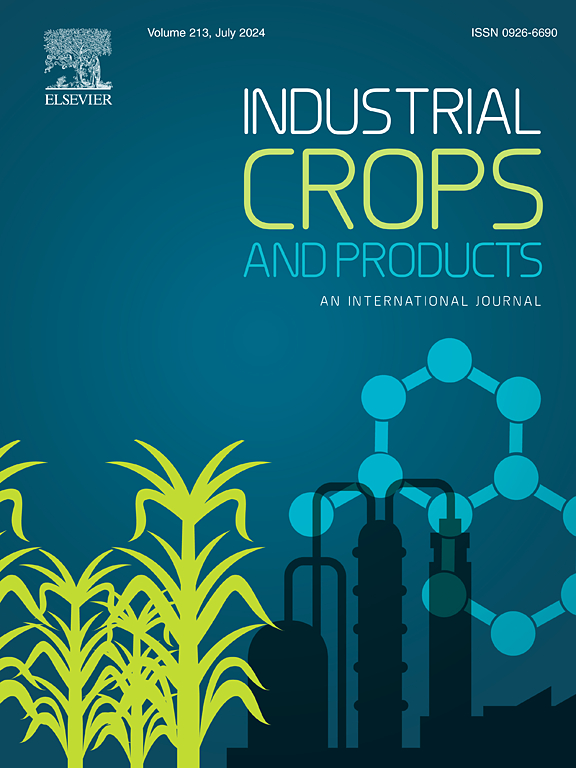Fabrication of water-stable soy protein isolate (SPI)/ carboxymethyl cellulose (CMC) scaffold sourced from oil palm empty fruit bunch (OPEFB) for bone tissue engineering
IF 5.6
1区 农林科学
Q1 AGRICULTURAL ENGINEERING
引用次数: 0
Abstract
Low structural integrity in hydrophilic polymers poses a significant challenge for bone tissue engineering (BTE) as these scaffolds are prone to premature collapse, potentially impeding bone regeneration. Additionally, there is a scarcity of research on sustainable approaches in bone scaffold fabrication, warranting further exploration given their biocompatibility. This study addresses these issues by fabricating water-stable, glutaraldehyde (GA) crosslinked soy protein isolate (SPI)/carboxymethyl cellulose (CMC) porous scaffolds using oil palm empty fruit bunch (OPEFB) waste as the starting material. The scaffolds were prepared through blending, crosslinking, and freeze-drying processes, followed by several characterisation experiments to assess morphology, porosity, mechanical properties, and degradation rate. The results showed that the SPI/CMC scaffolds exhibited a rough surface morphology with an average pore size ranging from 65 ± 13 μm to 99 ± 8 μm. The porosity of the SPI/CMC-based scaffolds was higher than that of the SPI-based scaffolds, though the increased porosity led to a lower Young’s modulus. A decrease in Young’s modulus was observed with increasing CMC content, attributed to the inefficiency of SPI-GA crosslinking. The scaffolds demonstrated a slow degradation profile over 35 days of incubation in simulated body fluid (SBF), indicating their potential to retain structural integrity over extended periods. Additionally, a fluctuating weight change due to calcium phosphate deposition suggested the bioactive properties of the scaffolds. In vitro studies revealed that these waste-derived scaffolds supported and maintained cellular proliferation of human fetal osteoblast (hFOB) cells, with good cell attachment observed, highlighting their potential for BTE applications. This study demonstrates that the SPI/CMC scaffold with GA crosslinking effectively provides structural stability in aqueous environments and can be further improved as one of the potential candidates for the BTE scaffold.

油棕空果串(OPEFB)水稳定大豆分离蛋白(SPI)/羧甲基纤维素(CMC)骨组织工程支架的制备
亲水聚合物的低结构完整性对骨组织工程(BTE)提出了重大挑战,因为这些支架容易过早塌陷,潜在地阻碍骨再生。此外,关于骨支架制造的可持续方法的研究很少,鉴于其生物相容性,需要进一步探索。本研究以油棕空果束(OPEFB)为原料,制备了水稳定的戊二醛(GA)交联大豆分离蛋白(SPI)/羧甲基纤维素(CMC)多孔支架。通过共混、交联和冷冻干燥工艺制备支架,随后进行了几项表征实验,以评估其形态、孔隙度、机械性能和降解率。结果表明,SPI/CMC支架表面形貌粗糙,平均孔径为65 ± 13 μm ~ 99 ± 8 μm;SPI/ cmc基支架的孔隙率高于SPI基支架,但孔隙率的增加导致杨氏模量的降低。随着CMC含量的增加,杨氏模量下降,这是由于SPI-GA交联效率低下所致。在模拟体液(SBF)中培养35天后,支架显示出缓慢的降解特征,表明它们在较长时间内保持结构完整性的潜力。此外,由于磷酸钙沉积引起的重量波动变化表明支架具有生物活性。体外研究表明,这些废物来源的支架支持和维持人胎儿成骨细胞(hFOB)的细胞增殖,并观察到良好的细胞附着,突出了它们在BTE应用的潜力。本研究表明,具有GA交联的SPI/CMC支架在水环境中有效地提供了结构稳定性,并且可以进一步改善作为BTE支架的潜在候选材料之一。
本文章由计算机程序翻译,如有差异,请以英文原文为准。
求助全文
约1分钟内获得全文
求助全文
来源期刊

Industrial Crops and Products
农林科学-农业工程
CiteScore
9.50
自引率
8.50%
发文量
1518
审稿时长
43 days
期刊介绍:
Industrial Crops and Products is an International Journal publishing academic and industrial research on industrial (defined as non-food/non-feed) crops and products. Papers concern both crop-oriented and bio-based materials from crops-oriented research, and should be of interest to an international audience, hypothesis driven, and where comparisons are made statistics performed.
 求助内容:
求助内容: 应助结果提醒方式:
应助结果提醒方式:


